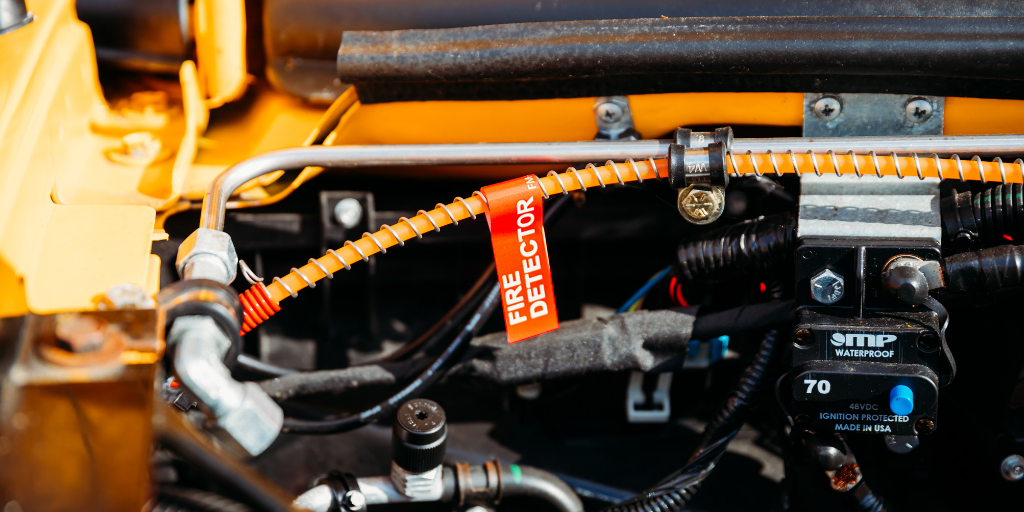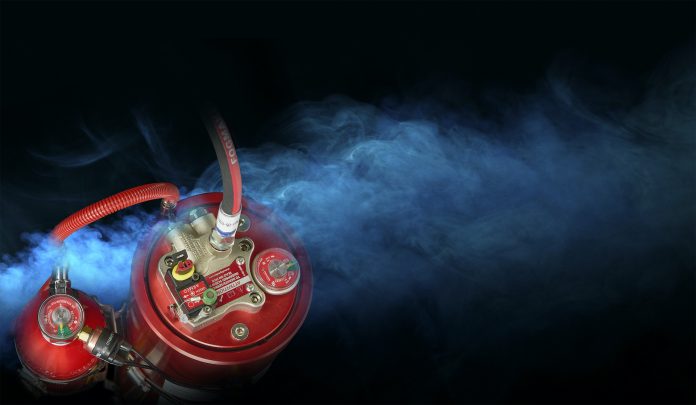School bus fires occur daily across the U.S., according to the latest government data. Assuming a fire can ignite in even the most well-equipped and maintained bus, the school transportation industry is stepping up its efforts to better protect riders through investments in safety programs and fire suppression products.
The motivation for increased safety measures occasionally stems from high-profile incidents.
The Houston Independent School District encountered a close call on Jan. 29, when a school bus caught fire while on a route. A student passenger in a wheelchair and three support staff were riding in the bus at the time.
The bus driver, attendant and nurse had to lower the ramp to remove the student from the bus, which added time to the evacuation. No one was hurt, and the cause of the fire is still under investigation. While HISD administrators assured the public through its website that “student safety and well-being are always a top priority,” the close call will undoubtedly remain in the forefront of future safety planning in Texas and beyond.
School bus fires are nothing new. They have caused anxiety, debate and frustration industry-wide for decades. The issue is especially precarious for special needs routes, like the one in Houston, where transportation staff requires additional time to evacuate students who may have many physical and cognitive disabilities.
Despite a number of fire suppression solutions on the market—which are not to be confused with fire extinguishers that are required for the school bus cabin—adding requirements have become a top priority within the industry. That trend follows a tragic December 2017 school bus fire that took the lives of a 16-year-old student and elderly driver in Oakland, Iowa.
In that incident, the National Transportation Safety Board concluded that the driver and student would have had extra time to evacuate, if the school bus had been equipped with a suppression system in the engine compartment, where the fire started.
According to NTSB investigators, the two victims were unable to escape the fumes and flames. The situation was exacerbated by the driver’s inability to move, due to a chronic back injury, for which he was scheduled to undergo surgery the following week.
In response to the incident, the NTSB adopted new recommendations last June that included a call to require fire suppression systems in all new school buses, as well as retrofit all of the buses that are already in use. The agency also urged the industry to develop a standard to improve the construction of firewalls between the school bus engine and passenger compartments, and it called for the implementation of more rigorous driver physical fitness requirements.
Fire suppression adoption remains slow, however. One of the big reasons is cost, with systems ranging from $1,500 to over $4,000 per bus. Only 8 percent of 227 readers who responded to a School Transportation News survey this month said they have installed fire suppression systems on their special needs buses. The top two reasons they reported for not installing the system are cost and a lack of standard systems installed by OEMs on the production line.
Even then, confusion between fire suppression systems and fire extinguishers continues to cloud the issue, as illustrated by the Houston ISD incident.

District communication officials initially told School Transportation News that all of its school buses are equipped with suppression systems. However, they confused fire suppression with fire extinguishers, as several student transporters have also admitted. Houston ISD provides the state-mandated fire extinguishers inside the school bus, and with the requirements that the systems are included in pre-service driver safety training. They are also covered during refresher training that is provided throughout the school year.
The district also said the school bus driver inspected the fire extinguishers prior to the Jan. 29 route, as is required by the standard pre-trip safety check.
Help to Prevent Fires
While some states and local school districts are still waiting to install fire suppression systems, districts elsewhere are already using them. Soon after the NTSB’s recommendation was released, Mobile County Public Schools in Alabama announced immediate plans to deploy fire suppression systems in 100 special-needs buses, and eventually in all 600 buses in its fleet. It then contracted with Fogmaker North America, a USSC Group company, for a retrofit.
Fire Danger
Between one and two school bus fires occur every day, according to a 2016 study by the John A. Volpe National Transportation Systems Center, titled “Motor Coach and School Bus Fire Safety Analysis.” The Volpe report said that over 380 of these fires are reported every year on school buses in the U.S.
The National Transportation Safety Board also presented some statistics to provide a clearer picture of these fire dangers. Deaths resulting from school bus fires are rare but can be severe in worst cast scenarios.
On the other hand, school bus fires that were reported resulted in no direct injuries or fatalities. In fact, the average reported property damage per incident was just a fraction of the total cost of the vehicle.
The NTSB also called for an improvement in data quality and reporting, as well as operational training, vehicle design and equipment development.
Last year, USSC Group reported a spike in sales and interest for its products. When a fire erupts, the Fogmaker system releases a high-pressure water mist to reduce heat. The company also provides its customers with training, plus inspections of firewalls and fire suppression systems, said Ken Hedgecock. He joined Fogmaker North America in December as national sales manager, after working for three decades with Thomas Built Buses.
Meanwhile, all newly purchased special-needs school buses in Georgia have been required to have fire suppression systems since 2001, confirmed Pat Schofill, the director of pupil transportation with the Georgia Department of Education. The state specs were updated several years ago to allow water-based systems, in addition to power-based systems.
Cliff Shearouse, executive director of transportation services for Henry County Schools, located southeast of Atlanta, reported that most of the district’s special needs buses are equipped with Amerex systems, while other buses have the Jomarr system. But luckily, none of the systems have been deployed due to a fire.
The engine compartment is the hazard zone where fires most commonly occur, according to Fireaway, Inc., which manufactures a fire suppression canister system under the brand name of Stat-X. Engine bay fires occur for various reasons, such as mechanical failures or loose wires that rub against engine or chassis parts. Overheated wheels and brake components are also common fire sources.
Kidde Technologies, which serves the aviation and commercial bus markets, recently introduced its Student Transport Automatic Fire Sensing and Suppression System for school buses. The system deploys a dry suppressant if a fire ignites in the engine or battery compartments.
Firetrace International produces a tube that provides a continuous loop of fire detection in any hazard area on a vehicle. The loop is coupled with a suppression system that deploys a dry chemical powder to extinguish fires.
A session that is scheduled for the TSD Conference this month in Frisco, Texas, discusses what the NTSB recommendation means for special needs transporters. It will also review the experience that school districts have had when using fire suppression systems on route buses.
Editor’s Note: As reprinted from the March issue of School Transportation News.


















